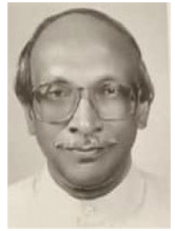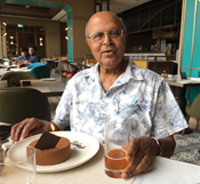Appreciations
View(s):Like his paternal ancestors he too did his bit for the betterment of society
Prof. Hiran D. Dias
 Prof. Hiran D. Dias passed away at the age of 89 on February 28. He was born on February 25, 1934 in his parental ancestral home in Panadura. His father was Charlie Dias and mother was Freda Dias.
Prof. Hiran D. Dias passed away at the age of 89 on February 28. He was born on February 25, 1934 in his parental ancestral home in Panadura. His father was Charlie Dias and mother was Freda Dias.
After completing his high school education at S. Thomas’ College, Mount Lavinia, he went to the University of Cambridge, UK and in 1962, completed his PhD in Geography there. The topic of this thesis was Cottage Industries of Ceylon.
The elder brother of Prof. Dias’s father (Mahappa) was Arthur V. Dias (1886-1960) more popularly known as Kos Mama (Uncle Jak) – a planter, philanthropist, member of the Temperance Movement, independence activist, jakfruit campaign pioneer and national hero.
His paternal grandfather was Jeremias Dias from Panadura. Mrs Jeremias Dias, nee Selestina Rodrigo (1858-1933) founded a Buddhist girls’ school in 1916 in Colombo 3 which is now Visakha Vidyalaya.
After completing his studies abroad, he returned to Sri Lanka and joined the University of Ceylon, Peradeniya where he met his life’s partner Erika. They married in 1959 in Colombo.
Prof. Dias was my geography lecturer when I was at the University of Ceylon, Colombo Campus. He was the Proctor of the Campus and was promoted as the President in the late 1960s. He pedaled his push bicycle wearing corduroy slim-fit trousers and bush shirt through the busy roads in Colombo. In 1972, when the Agrarian Research and Training Institute (ARTI) was established, he joined as a Senior Researcher.
In 1978, Prof. Dias joined the Asian Institute of Technology (AIT) in Bangkok, Thailand as a Professor of Rural Development Planning and later was Head of the Human Settlements Division. For the graduation ceremony all faculty members of AIT used to wear a full suit along with different academic outfits; whereas Prof. Dias being very patriotic wore the Sri Lankan white national dress on such occasions.
In 1985, when I went to the AIT for my MSc, I met him for the second time. Besides being a lecturer, his wife Erika was a relation of my wife Chandani. When Chandani and my daughter Rowanthi joined me at the AIT (Aug. 1985), we visited Prof. Dias’s home in Bangkok. During that time, we used to meet Prof. Dias, Erika Akka and their two sons Neshan and Agashan very often. I can still remember when Rowanthi was sick, Prof. Dias and Erika Akka took Chandani and Rowanthi to their home in Bangkok for treatment. After nearly one week when Rowanthi was fully recovered, Chandani and Rowanthi were dropped at our home in the AIT student village.
After retirement from AIT (1995), Prof. Dias and Erika came back to Sri Lanka. He established a consultancy firm named Vikasitha (Blossom-up) offering consultancy services. In 2009, he became the Chairperson of the Centre for Poverty Analysis (CEPA). He initiated the non-Governmental Development Organization (NGDO) and the CHAKRA consortium to design and conduct training programmes for Managers of NGDO in the Asian region. He was closely associated with these activities and his loving wife Erika walked along with him.
Just like his paternal ancestors had made enormous contributions to the upliftment of society, Prof. Dias in his own way, made his own contribution for the betterment of the motherland.
Prof. Dias and Erika Akka maintained their sweet home as an Ashram not only to practise Dhamma daily but also to conduct dhamma discussions with their friends and relations. My dear Sir, your relentless practice of the Dhamma will certainly be of help to shorten your sojourn in Sansara.
Senaka A. Samarasinghe
From medicine to art her canvas of life took on different shades
Dr Kamala de Silva nee Nimalasuriya
Dr. Kamala de Silva was born on June 13, 1942, in Colombo. She lived on Vajira Road, Colombo 5, and later at Dickman’s Road, Colombo 5. She attended Visakha Vidyalaya from the baby class until she entered the Ceylon Medical College in 1962.
At Visakha, she had an illustrious career, winning the class prize almost every year, and consistently spoke of becoming a doctor like her father, the well-known nutritionist, Dr Ananda Nimalasuriya. In her final year of high school, she was appointed Head Girl.
Kamala had a successful term in Medical College and was awarded a Nuffield Fellowship to attend a teaching hospital in London. She attended Kings College Hospital Medical School for a three-month period and returned to Colombo Medical College, graduating as a Doctor in 1967 and winning the Gold Medal in Medicine at the Final MBBS.
She went to England for postgraduate studies and worked in well-known teaching hospitals, as well as at Hammersmith Hospital, London. She was successful in passing the MRCP (London) in 1970.
She returned to Sri Lanka and was employed as a consultant Physician, working at hospitals in Matara, Badulla, Galle, and Colombo South Hospital for ten years.
She migrated to Australia in 1980 with her husband and two young children. The family resided in a suburb in the Newcastle area. Kamala adapted very quickly to the new environment. Looking after her two active growing boys, aged five and seven, was quite a full-time job. The children walked to school, and the weekends were spent taking them to various sporting activities.
As time went by, the children became more independent, and Kamala was able to return to her medical work. Although recognised as a Physician, she was not able to do full-time work. She did some teaching at Newcastle University and also did short-term work for general practitioners. Besides medical work, Kamala was most interested in painting with oil and watercolor. She attended a regular art class. She was also very keen on pottery and ceramic painting, and many of her ceramic works were gifted to her friends. She was very fond of Renaissance art and enjoyed visiting galleries during travels in Europe. She was also keen on the opera and was a regular visitor to the Sydney Opera House.
Unfortunately, her life was cut short at the age of 71 years as she developed a blood disorder and passed away in April 2013. She left behind her husband, Srian, and her boys Sam and Rajit.
Srian de Silva
A simple and disciplined man he was well known in the hospitality trade
M.T.A.Furkan
 Prof. M.T.A Furkhan was a prominent figure in the hospitality trade of Sri Lanka. He was well known for his educational, business, and philanthropic achievements, which were all significant milestones in his career. However, I had the privilege of getting to know Prof. Furkhan on a personal level during my years serving on the board of Eden Resort and Spa, which was his most passionate project.
Prof. M.T.A Furkhan was a prominent figure in the hospitality trade of Sri Lanka. He was well known for his educational, business, and philanthropic achievements, which were all significant milestones in his career. However, I had the privilege of getting to know Prof. Furkhan on a personal level during my years serving on the board of Eden Resort and Spa, which was his most passionate project.
Even though he was a close relative of my grandfather and friend of my father, I never had the opportunity to meet and talk to him in person, except for brief greetings during family events. Uncle Furkhan as I used to call him was a successful and mature businessman, while I was just a young boy when we first met on the Eden project. He proposed the project to my father, who owned a land in a pristine stretch of the Golden Mile in Beruwela
Unfortunately, my father passed away suddenly after a brief illness, and I was tasked with completing the deal as the eldest member of the family.
I was appointed to the Board of Eden in 1992, and that marked the beginning of my long journey with Uncle Furkhan or Prof. Furkhan as he was usually called on the project. He was a calm person who had a soft voice, even during board meetings, no matter how challenging the issues. He would listen to the problems and advise on what needed to be done.
He was a very disciplined man,
His day began at 6 a.m. He had his cup of tea and read the papers before leaving to office after breakfast. He would take a lunch break around 1 p.m., go home for a nap after lunch and be back at work by 3.30 p.m., retiring for the day around 5 p.m. Thereafter he spent his time reading, entertaining friends and family and had his dinner at 8. He went to bed by 10 p.m. He was very particular in following this routine, which kept him sharp and healthy.
He once told me that when he had an important meeting or had to attend one of his annual general meetings, he would take a full break the day before, and depending on the time of the meeting he would take a nap before the meeting. He would then study the agenda and would ponder on the speech he was to give and attend the meeting fully refreshed.
He always had a positive outlook in life, even during challenging times like the JVP insurrection in 1987, when all hotels in the south were forced to close. When I asked him how he handled it, he told me that everything happens for the good and that he never took his worries to bed, making sure that he has a good night’s sleep. He told me that even if he got a call in the middle of the night informing him that his hotels were burning, he would go back to sleep and handle the problem only after waking up and being back in office the next day.
During the 2004 tsunami, Eden Resort and Spa was devastated. Prof. Furkhan called a meeting and advised the board to repair the hotel and get back to business as soon as possible, making all necessary arrangements to do so. Eden was back in business within two months and was the first hotel to open in the south coast after the tsunami He always had a good team and his positive attitude is what struck me most.
He loved fishing and took frequent vacations overseas to relax, think, and rejuvenate. He was a simple person who was frugal in spending on luxuries. He always dressed modestly, wore only one watch – a timely Omega – until the last day I met him. He lived in the very same house all his life and owned one car which he always liked to be a Mercedes Benz -he changed models about three times in his lifetime
He retired in 2011 and spent most of his last years at home – reading, learning, attending to philanthropic work and keeping in touch with family, friends and colleagues until his demise in May 2022.
Ifham Raji
Searching for an ideal partner? Find your soul mate on Hitad.lk, Sri Lanka's favourite marriage proposals page. With Hitad.lk matrimonial advertisements you have access to thousands of ads from potential suitors who are looking for someone just like you.


